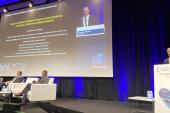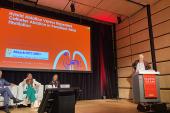EHRA, Others Update Consensus on Catheter and Surgical Ablation of AF
The hope is that this will make ablation safer and increase the number of patients considered candidates, Stylianos Tzeis says.

BERLIN, Germany—In response to technological advances over the past several years, heart rhythm societies from around the world have released a comprehensive new expert consensus statement on catheter and surgical ablation of atrial fibrillation (AF).
Following the first such multisociety statement released in 2007 and updates in 2012 and 2017, the field of AF ablation has evolved with accumulating evidence on safety and effectiveness in various clinical scenarios and improvements in technology, including the emergence of pulsed-field ablation (PFA) catheters and increasing use of intracardiac echocardiography (ICE) to guide the procedure.
Thus, “we definitely needed an update in order to have a contemporary landscape,” said Stylianos Tzeis, MD, PhD (Mitera Hospital, Athens, Greece), European Heart Rhythm Association (EHRA) chair of the writing committee for the new document, which was released to coincide with the EHRA Congress 2024 held here.
EHRA collaborated with the Heart Rhythm Society, the Asia Pacific Heart Rhythm Society, and the Latin American Heart Rhythm Society to craft the guidance, published online in EP Europace, Heart Rhythm, the Journal of Arrhythmia, and the Journal of Interventional Cardiac Electrophysiology.
Coming in at 107 pages, with 1,467 references, the document provides a comprehensive overview of what’s known about AF and how to treat it with catheter or surgical ablation. It begins with a discussion about the classification, natural history, and pathophysiology of AF before moving into anatomical considerations and indications for catheter ablation. The authors provide advice on management of patients before, during, and after the procedure, as well as on how to handle complications and what the training and institutional requirements should be to perform it. There is also a section on surgical or hybrid ablation.
The statement contains a color-coded system of clinical advice, with dark green indicating what should be done, light green denoting what may be appropriate, red signaling practices that should be avoided, and gray highlighting areas of uncertainty. Each piece of advice had to be supported by at least 80% of the writing committee members, with the average support being 94%.
Indications, the Blanking Period, and Other Advice
Tzeis said the authors tried to make this latest version of the statement more practical and more educational, covering the whole trajectory of a patient who eventually undergoes ablation. Among the major highlights, he said, was a strengthening of the advice for performing catheter ablation in certain scenarios. The authors say ablation is beneficial as a first-line option in symptomatic patients with recurrent paroxysmal AF and also is beneficial for improving LV function in patients with AF and LV systolic dysfunction that is believed to be related to arrhythmia-mediated cardiomyopathy.
A key question is how to determine whether a reduced ejection fraction is due to AF, and Tzeis pointed to a table in the document outlining characteristics associated with LVEF recovery after AF ablation to help clinicians sort it out.
As for ablation strategies, Tzeis said pulmonary vein isolation (PVI) remains the cornerstone of AF ablation, with advice to achieve it during all AF ablation procedures. The benefit of any additional ablation measures remains unclear. “Unfortunately, we don’t have any data regarding the adjunctive ablation strategy on top of PVI that could prove consistently helpful in patients with persistent atrial fibrillation,” he said.
Of note, the authors don’t provide a preference for any specific type of ablation technology due to the lack of evidence that any is better than the others. “We just state catheter ablation irrespective of the energy that you use because the procedural endpoints are standardized,” Tzeis said. “So you should achieve PVI, at least in paroxysmal AF.”
For procedural management, the document reflects an upgraded role for ICE to exclude atrial thrombus, saying that intraprocedural ICE is a reasonable option along with performing transesophageal echocardiography or cardiac CT in the 48 hours before ablation. In addition, use of esophageal temperature monitoring during catheter ablation has been relegated to an area of uncertainty.
The authors provide important clinical advice regarding postprocedural anticoagulation and antiarrhythmic treatment, Tzeis said. For instance, systemic anticoagulation should be given for at least 2 months following ablation, with a preference for direct oral anticoagulants over vitamin K antagonists in patients not previously on anticoagulation.
Other key changes in the new document, ones with implications for clinical trials, are a reduction in the recommended blanking period after ablation from 3 months to 8 weeks and advice to use AF burden as an endpoint for the assessment of procedural results. “I think it’s totally unfair to try to define the outcome of the procedure based in a dichotomous model, successful or not successful. We should move a bit ahead. And this is the reason why we strongly suggest having this quantitative assessment with the endpoint of AF burden,” Tzeis said.
A Lot of Work Ahead
This new consensus statement provides a detailed look into a focused area of AF management, something that isn’t possible in the context of the AF practice guidelines, which provide a broader look at treating the arrhythmia, Tzeis said. “I think they are more or less complementary, he said, referring to the consensus statement and guidelines.
After the release of the consensus statement, “the main impact that I would like to see is to make catheter ablation even safer, because I think this is something that is absolutely needed, and to increase the number of patients that are considered suitable candidates based on the indications,” Tzeis said. “And I think this is very important because the needs for invasive management of this arrhythmia . . . are exceptionally high.”
Still, there are many areas ripe for additional research, particularly prospective randomized controlled trials, as highlighted by a section at the end of the document. “We have new tools and probably we need to reconsider some of the things that we really believed in regarding what’s the indicated adjunctive strategy and what should you do on top of PVI,” Tzeis said. “There is still a lot of work to be done.”
Todd Neale is the Associate News Editor for TCTMD and a Senior Medical Journalist. He got his start in journalism at …
Read Full BioSources
Tzeis S, Gerstenfeld EP, Kalman J, et al. 2024 European Heart Rhythm Association/Heart Rhythm Society/Asia Pacific Heart Rhythm Society/Latin American Heart Rhythm Society expert consensus statement on catheter and surgical ablation of atrial fibrillation. Europace. 2024;Epub ahead of print.
Disclosures
- Tzeis reports speaking fees, advisory board fees, and honoraria from Abbott, Bayer, Pfizer, and Biosense Webster.





Comments